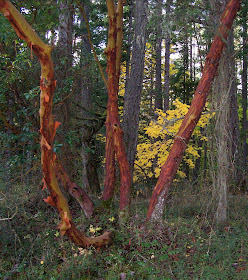 |
| Bigleaf maple provide a splash of yellow on Lower Thetis Lake trail |
Here the giant centuries old conifers rule the land while deciduous trees are relegated to the fringes and clearings of the forest.
 |
| Arbutus is a broad-leaf tree that keeps its leaves, but continuously sheds its bark- deciduous and evergreen. |
Dense stands of mature conifer forest contain few colourful fall trees, but where the continuous canopy is broken, broad leaf trees fill in. Rocky outcrops form clearings in the forest, providing space for Garry oak and Arbutus to move in.
Arbutus is Canada's only broad-leaved conifer - it does not shed its leaves in the fall, and they are green year round. However, this beautiful, sun-loving tree does shed its orange-brown bark to reveal the fresh green bark underneath.
 |
| Large Bigleaf maple, Sooke River Road |
 |
| Barrow's Goldeneye |
Local lakes and rivers often have large Black cottonwoods growing along the freshwater waterfront. These massive moisture-loving trees provide perches and nesting sites for eagles and other large birds of prey.
More than 60% of the world's Barrow's goldeneyes nest in Black cottonwood trees. Right now cottonwoods heart-shaped leaves are turning yellow and carpeting the forest floor.
 |
| Black cottonwood form the upper canopy along the Goldstream River |
Deciduous trees are a small yet important part of the coastal forest ecosystem. They are the pioneer trees that reclaim disturbed areas for the future conifer forest. Red alder, usually the first tree to colonize areas like clear cuts, can fix nitrogen into a form plants can use. Deciduous leaves are less acidic than conifer needles, and are a rich source of nutrients for building the soil.
Broad-leaved trees also provide important wildlife habitat. Woodpeckers excavate new cavity nests each year, and these are frequently made in deciduous trees. Deciduous don't live as long, and decay faster than the resinous, long-lived conifers, making them perfect for cavity nesting.
 |
| Downy and Hairy woodpeckers need deciduous trees for nests |
Over 20 species in British Columbia are secondary cavity nesters, animals that can not excavate their own nests. These creatures move in to the year old abandoned holes, and include saw-whet owls, black-capped chickadees, flying squirrels, and martin.
Although the deciduous contingent of the coastal forest may be hard to see throughout the summer, their fall colours make it difficult for them to go unnoticed, giving them their moment of much-deserved glory.
Arbutus, a member of the Ericaceae family, labeled as a broad-leaf conifer...now that's one more typo!
ReplyDeleteOuch - thank you for bringing the error to my attention.
Delete